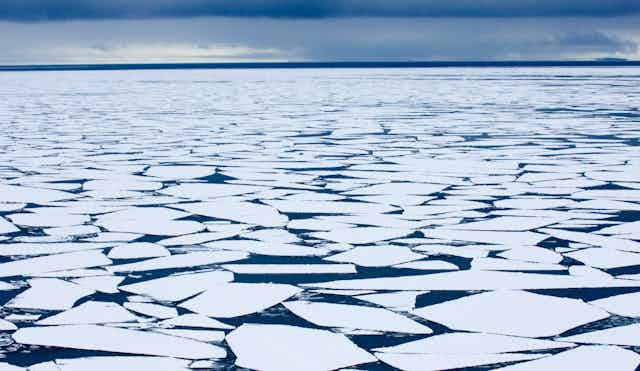A changing climate is upon us, with more frequent land and marine heatwaves, forest fires, atmospheric rivers and floods. For some, it is the backdrop to day-to-day life, but for a growing number of people it is a life-changing reality.
It is now more remarkable when a year is not the hottest since our species began to develop civilisations.
Whenever we experience extreme climate events, it can be hard to engage with the concept that they are minor blips in the planetary experiment we are conducting. But the main act is taking place elsewhere in the oceans, which soak up more than 90% of the excess heat energy.
We are winding up a clockwork spring without knowing exactly when, how fast and how it will unspool. Ocean heating is not so much a canary in a coal mine but a thrashing shark we’ve inadvertently (at least initially) hauled up into our fishing boat.
A bonfire of records
A drop in the area covered by sea ice, both in the Arctic and more recently also in Antarctica, is one of the latest record-breaking changes. These floating expanses of frozen seawater are central to how our world works. They regulate how much light our planet reflects, help ventilate the oceans, and host important ecosystems in the form of algal meadows on their underside.
But now, due to the warming of the ocean, we have the lowest sea ice area ever recorded.
Ocean scientists are not used to thinking of rapid change, but the trajectory of the global average temperature on the surface of the ocean has now entered uncharted territory – and fast.

We know about the scale of this thanks to satellite technology that can sense small changes in temperature at the ocean surface.
These surface data are just that: the temperature of the very skin of the ocean. To get a sense of warming in the deeper ocean, we use ship-based measurements and a fleet of underwater robots known as Argo.

The global ocean heat transport
The deep ocean is clearly changing. This is because polar sea ice acts as a connector between the atmosphere, the surface of the ocean and deeper waters. With less sea ice, there is less cold, salty, oxygenated water sinking to the deep ocean.
These freezing coastal waters of Antarctica are a crucial engine room for global currents that convey energy around the planet – and this ocean transport mechanism is now changing.
One of the unknowns of ocean warming is how the oceans will adjust and store all the heat. Heating the ocean surface makes the upper reaches more stable. This in turn changes how the upper ocean absorbs carbon dioxide.
The difficulty for researchers determining how best to respond is that the processes that move and mix this heat operate over very small scales. It is beyond even our most powerful climate simulators to model exactly how the heat is spread, making predictions less certain.
Even if our models could work at very big and very small scales at the same time, they would have few data for validation. This is because very little of the ocean’s mixing has been observed directly.
While we can predict some of this mixing, the ocean is full of surprises. Recently, the Drake Passage has been shown to be even more of a mixing hotspot than previously thought.

A warming Pacific

Despite the connected ocean, the individual basins have their own characteristics and contributions to climate. Aotearoa New Zealand sits in the southwest corner of the Pacific Ocean, which covers about a third of the globe’s surface.
The Pacific is so large it has its own internal cycles, such as the El Niño Southern Oscillation (ENSO). We have to disentangle these to understand long-term changes.
While El Niño conditions can bring marine heatwaves to some areas of the Pacific, the oceans around Aotearoa New Zealand, especially to the south, are already experiencing nearly constant marine heatwaves.
Read more: It might be the world's biggest ocean, but the mighty Pacific is in peril
The scale of the oceanic contribution to storing heat means any small change to how this has operated over the past millennia may have very large impacts. It is impossible to overstate the urgency with which we need to reduce greenhouse gas emissions.
Technologies that can capture already emitted carbon dioxide have many proponents, but they must not come at the expense of efforts to turn off emission sources. Without removing the drivers of emissions, these stop-gap measures will only delay the inevitable. As the Intergovernmental Panel on Climate Change put it in its latest report:
There is a rapidly closing window of opportunity to secure a liveable and sustainable future for all.

